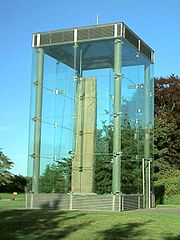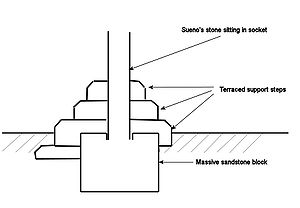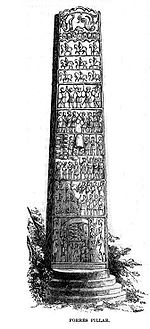
Sueno's Stone
Encyclopedia

Forres
Forres , is a town and former royal burgh situated in the north of Scotland on the Moray coast, approximately 30 miles east of Inverness. Forres has been a winner of the Scotland in Bloom award on several occasions...
, Scotland
Scotland
Scotland is a country that is part of the United Kingdom. Occupying the northern third of the island of Great Britain, it shares a border with England to the south and is bounded by the North Sea to the east, the Atlantic Ocean to the north and west, and the North Channel and Irish Sea to the...
. It is the largest surviving Pictish stone of its type in Scotland
Scotland
Scotland is a country that is part of the United Kingdom. Occupying the northern third of the island of Great Britain, it shares a border with England to the south and is bounded by the North Sea to the east, the Atlantic Ocean to the north and west, and the North Channel and Irish Sea to the...
. It is situated on a raised bank on a now isolated section of the former road to Findhorn.
One or two stones?
Evidence from Timothy PontTimothy Pont
Timothy Pont was a Scottish topographer, the first to produce a detailed map of Scotland. Pont's maps are among the earliest surviving to show a European country in minute detail, from an actual survey.-Life:...
’s Mapp of Murray (c 1590), the more modern military maps of Roy and Ainslie (1750 and 1789 respectively) and Robert Campbell's map of 1790 all show Sueno’s Stone along with another stone that has now disappeared. The fact that Pont's map shows the standing stones at all indicates their size as Pont does not show any other obelisks anywhere. Ainslie has inscribed on his map ‘two curiously carved pillars’. The fact that these maps show the pillar(s) in their present (at least approximate) position belies the notion that it was found elsewhere and re-erected at its present location. Hector Boece
Hector Boece
Hector Boece , known in Latin as Hector Boecius or Boethius, was a Scottish philosopher and first Principal of King's College in Aberdeen, a predecessor of the University of Aberdeen.-Biography:He was born in Dundee where he attended school...
(c1465–1536) (not known entirely for his historical accuracy) mentions the stone and attributes it to Sueno. Lady Ann Campbell, the Countess of Moray, is noted in the early 1700’s as carrying out maintenance on the stone in an attempt to stabilise it. This was achieved by constructing stepped plinths around the base and these are what can be seen today. Archaeological excavations carried out in 1990 and 1991 suggest that it may originally have been one of two monumental stones.
Description

Old Red Sandstone
The Old Red Sandstone is a British rock formation of considerable importance to early paleontology. For convenience the short version of the term, 'ORS' is often used in literature on the subject.-Sedimentology:...
which is prevalent in the Laigh o’ Moray but has suffered considerable weathering in places. The western face has a carved Celtic cross
Celtic cross
A Celtic cross is a symbol that combines a cross with a ring surrounding the intersection. In the Celtic Christian world it was combined with the Christian cross and this design was often used for high crosses – a free-standing cross made of stone and often richly decorated...
with elaborately interlaced decoration and a poorly preserved scene set in a panel below the cross. The east face has four panels that show a large battle scene. The top panel is quite weathered and shows rows of horsemen. The second panel depicts armed foot soldiers and the third panel shows the decapitated vanquished soldiers, the heads piled up, and soldiers, archers and horsemen surrounding what may be a broch. The base panel depicts the victorious army leaving the battle field. In the early 1990s
1990s
File:1990s decade montage.png|From left, clockwise: The Hubble Space Telescope floats in space after it was taken up in 1990; American F-16s and F-15s fly over burning oil fields and the USA Lexie in Operation Desert Storm, also known as the 1991 Gulf War; The signing of the Oslo Accords on...
the stone was encased in armoured glass to prevent further erosion and also graffiti
Graffiti
Graffiti is the name for images or lettering scratched, scrawled, painted or marked in any manner on property....
.
Interpretations


600
Year 600 was a leap year starting on Friday of the Julian calendar. The denomination 600 for this year has been used since the early medieval period, when the Anno Domini calendar era became the prevalent method in Europe for naming years.- Europe :* Smallpox arrives in Europe for the first...
and AD 1000. Two separate but similar patterns were discerned and may relate to the second stone. There is general agreement that the stone dates to between the 9th and 10th centuries and greater accuracy is probably not possible. The examination of the carvings has been carried out to compare the style and also to interpret the figurative and historical significance. The Irish crosses of the 10th century are similar with their interweaving patterns and crowded panels of figures.. One hypothesis is that the figures depicted in the battle, parade and decapitation scenes is the army of Kenneth MacAlpin
Kenneth I of Scotland
Cináed mac Ailpín , commonly Anglicised as Kenneth MacAlpin and known in most modern regnal lists as Kenneth I was king of the Picts and, according to national myth, first king of Scots, earning him the posthumous nickname of An Ferbasach, "The Conqueror"...
(Cináed mac Ailpín), the scene being the representation of Kenneth's demonstration of his military and legal authority over northern Pictland. The two side panels have sinuous vine patterns populated with men as depicted in the Book of Kells. This suggests a date of between AD 800
800
Year 800 was a leap year starting on Wednesday of the Julian calendar. It was around this time that the Anno Domini calendar era became the prevalent method in Europe for naming years, so from this time on, the years began being known as 800 and onwards.- Europe :* December 25 - Pope Leo III...
and AD 900
900
Year 900 was a leap year starting on Tuesday of the Julian calendar.- Asia :* April 21 – Namwaran and his children, Lady Angkatan and Bukah, are granted pardon by the Datu of Tondo, as represented Jayadewa, Lord Minister of Pila, which released them of all their debts as inscribed in the...
. The traditional interpretation of the battle scene was that it shows a victory by Malcolm II
Malcolm II of Scotland
Máel Coluim mac Cináeda , was King of the Scots from 1005 until his death...
(Máel Coluim mac Cináeda) (reigned 1005–1034) against Danes or Norse led by one Sueno. This appears in Alexander Gordon
Alexander Gordon (antiquary)
Alexander Gordon was a Scottish antiquary and singer. His survey of Roman sites, the Itinerarium, was considered an essential reference by all Roman antiquaries of his time.-Early life and education:...
's Itinerarium Septentrionale of 1726 and is thought to have been ancient then, derived from folklore and the more learned histories of John of Fordun
John of Fordun
John of Fordun was a Scottish chronicler. It is generally stated that he was born at Fordoun, Mearns. It is certain that he was a secular priest, and that he composed his history in the latter part of the 14th century; and it is probable that he was a chaplain in the St Machar's Cathedral of...
, Hector Boece
Hector Boece
Hector Boece , known in Latin as Hector Boecius or Boethius, was a Scottish philosopher and first Principal of King's College in Aberdeen, a predecessor of the University of Aberdeen.-Biography:He was born in Dundee where he attended school...
and George Buchanan
George Buchanan (humanist)
George Buchanan was a Scottish historian and humanist scholar. He was part of the Monarchomach movement.-Early life:...
. However, this interpretation is no longer supported by historians and archaeologists.
Several more recent interpretations have been advanced. Anthony Jackson suggested that the stone displayed the final triumph of the Christian
Christian
A Christian is a person who adheres to Christianity, an Abrahamic, monotheistic religion based on the life and teachings of Jesus of Nazareth as recorded in the Canonical gospels and the letters of the New Testament...
Gaels
Gaels
The Gaels or Goidels are speakers of one of the Goidelic Celtic languages: Irish, Scottish Gaelic, and Manx. Goidelic speech originated in Ireland and subsequently spread to western and northern Scotland and the Isle of Man....
of Dál Riata
Dál Riata
Dál Riata was a Gaelic overkingdom on the western coast of Scotland with some territory on the northeast coast of Ireland...
over their, supposedly heathen, Pictish
Picts
The Picts were a group of Late Iron Age and Early Mediaeval people living in what is now eastern and northern Scotland. There is an association with the distribution of brochs, place names beginning 'Pit-', for instance Pitlochry, and Pictish stones. They are recorded from before the Roman conquest...
enemies, in which case it would have been erected by Kenneth MacAlpin
Kenneth I of Scotland
Cináed mac Ailpín , commonly Anglicised as Kenneth MacAlpin and known in most modern regnal lists as Kenneth I was king of the Picts and, according to national myth, first king of Scots, earning him the posthumous nickname of An Ferbasach, "The Conqueror"...
or his immediate successors. To say that much of Jackson's interpretation is problematic is to understate the case. As an alternative, Archie Duncan advances his theory that the stone records the defeat, death and reburial of Dub
Dub of Scotland
Dub mac Maíl Coluim , sometimes anglicised as Duff MacMalcolm, called Dén, "the Vehement" and Niger, "the Black" was king of Alba...
(Dub mac Maíl Coluim) in 966 or 967.
A modified form of Jackson's theory — stripped of much of the ingenious interpretation — is probably the present orthodoxy. This holds that Sueno's Stone commemorates an unknown victory by the men of Alba, the Gaelicised Picts of the lands south of the Mounth
Mounth
The Mounth is the range of hills on the southern edge of Strathdee in northeast Scotland. It was usually referred to with the article, i.e. "the Mounth". The name is a corruption of the Scottish Gaelic monadh which in turn is akin to the Welsh mynydd, and may be of Pictish origin...
over the men of Moray, those of the lands north of the Mounth.
Legend
Local legend says this was the crossroads where MacbethMacbeth
The Tragedy of Macbeth is a play by William Shakespeare about a regicide and its aftermath. It is Shakespeare's shortest tragedy and is believed to have been written sometime between 1603 and 1607...
originally met the three witches. In the legend, they were eventually imprisoned inside the stone—should the stone be broken they would be released. However this tale can date no further back than Shakespeare's
William Shakespeare
William Shakespeare was an English poet and playwright, widely regarded as the greatest writer in the English language and the world's pre-eminent dramatist. He is often called England's national poet and the "Bard of Avon"...
play.

